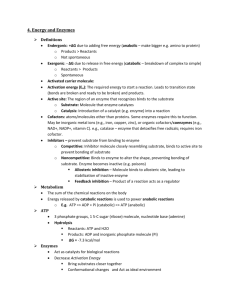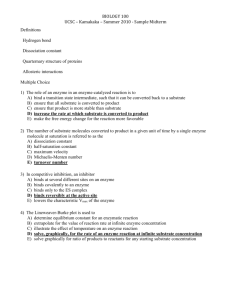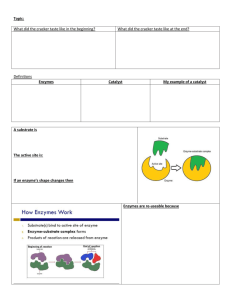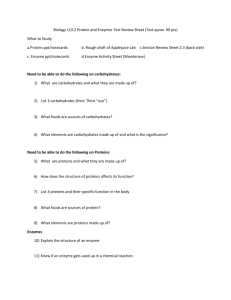Catalytic Strategies II & Enzyme Regulatory Strategies
advertisement
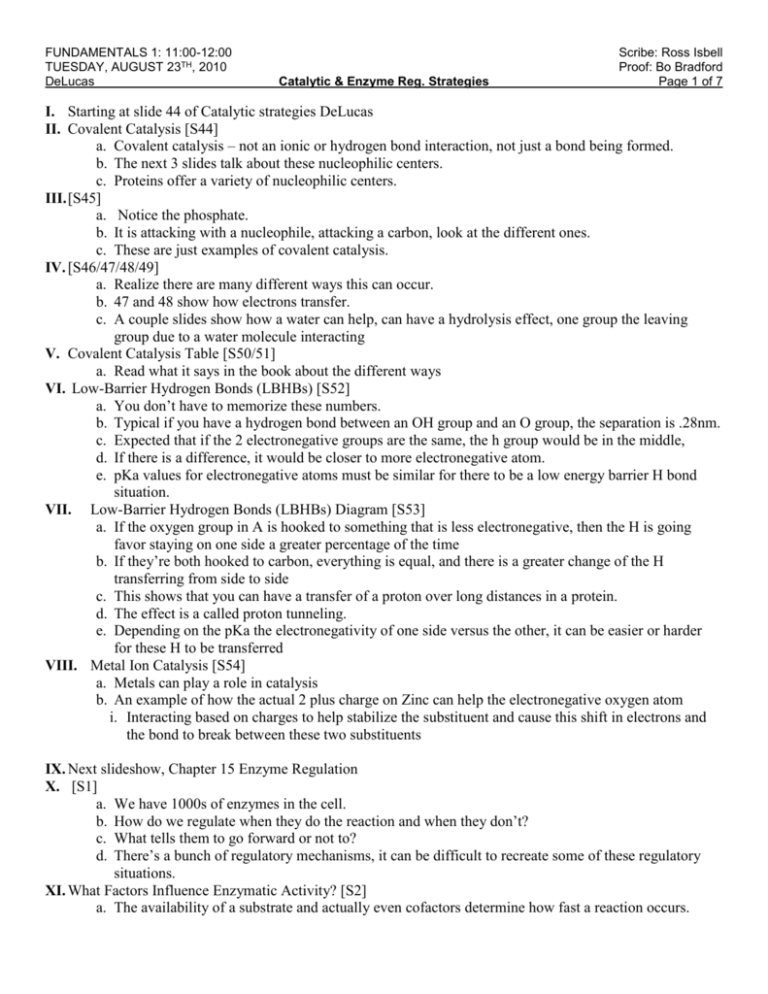
FUNDAMENTALS 1: 11:00-12:00 TUESDAY, AUGUST 23TH, 2010 DeLucas Catalytic & Enzyme Reg. Strategies Scribe: Ross Isbell Proof: Bo Bradford Page 1 of 7 I. Starting at slide 44 of Catalytic strategies DeLucas II. Covalent Catalysis [S44] a. Covalent catalysis – not an ionic or hydrogen bond interaction, not just a bond being formed. b. The next 3 slides talk about these nucleophilic centers. c. Proteins offer a variety of nucleophilic centers. III. [S45] a. Notice the phosphate. b. It is attacking with a nucleophile, attacking a carbon, look at the different ones. c. These are just examples of covalent catalysis. IV. [S46/47/48/49] a. Realize there are many different ways this can occur. b. 47 and 48 show how electrons transfer. c. A couple slides show how a water can help, can have a hydrolysis effect, one group the leaving group due to a water molecule interacting V. Covalent Catalysis Table [S50/51] a. Read what it says in the book about the different ways VI. Low-Barrier Hydrogen Bonds (LBHBs) [S52] a. You don’t have to memorize these numbers. b. Typical if you have a hydrogen bond between an OH group and an O group, the separation is .28nm. c. Expected that if the 2 electronegative groups are the same, the h group would be in the middle, d. If there is a difference, it would be closer to more electronegative atom. e. pKa values for electronegative atoms must be similar for there to be a low energy barrier H bond situation. VII. Low-Barrier Hydrogen Bonds (LBHBs) Diagram [S53] a. If the oxygen group in A is hooked to something that is less electronegative, then the H is going favor staying on one side a greater percentage of the time b. If they’re both hooked to carbon, everything is equal, and there is a greater change of the H transferring from side to side c. This shows that you can have a transfer of a proton over long distances in a protein. d. The effect is a called proton tunneling. e. Depending on the pKa the electronegativity of one side versus the other, it can be easier or harder for these H to be transferred VIII. Metal Ion Catalysis [S54] a. Metals can play a role in catalysis b. An example of how the actual 2 plus charge on Zinc can help the electronegative oxygen atom i. Interacting based on charges to help stabilize the substituent and cause this shift in electrons and the bond to break between these two substituents IX. Next slideshow, Chapter 15 Enzyme Regulation X. [S1] a. We have 1000s of enzymes in the cell. b. How do we regulate when they do the reaction and when they don’t? c. What tells them to go forward or not to? d. There’s a bunch of regulatory mechanisms, it can be difficult to recreate some of these regulatory situations. XI. What Factors Influence Enzymatic Activity? [S2] a. The availability of a substrate and actually even cofactors determine how fast a reaction occurs. FUNDAMENTALS 1: 11:00-12:00 TUESDAY, AUGUST 23TH, 2010 DeLucas Catalytic & Enzyme Reg. Strategies Scribe: Ross Isbell Proof: Bo Bradford Page 2 of 7 b. The speed of an enzyme break is proportional to the amount of substrate or substituents have to react in solution. c. As the product accumulates the reaction will decrease. d. If the purpose of an enzyme is to create some product, as product is continuously produced, at some point there is a signal that tells the enzyme - enough has been made, turn off. e. This signal can happen genetically. An enzyme can’t go fast if there is no enzyme. f. All proteins turn over, some last a little longer than others – minutes, hours, days, or weeks. But they all turn over. g. Transcription of the enzyme mRNA is regulated. One way the activity is regulated. h. The enzyme itself can have an active site and then somewhere else there can be a place that something that binds and either totally stops the activity or increases it. i. Because the binding location is in another place on the enzyme it is called an allosteric effect 1. Causes a conformational change that causes a change in the enzyme’s reactivity. 2. Allo means other. Can’t be in the active site, it’s some place else. j. Covalent modification - another way you can affect enzymes 1. Family of proteins called proteins kinases. a. Activate proteins by phosphorylating either a serine, threonine or tyrosine side chain in the other protein that they are interacting with. k. Zymogens - enzymes that aren’t active in one form, but then usually get clipped and when they do they become active. 1. Insulin is a good example. It starts as proinsulin (totally inactive). XII. Transcription Regulation [S3] a. The induction of the transcription process 1. Enzymes have a gene that codes for making that enzyme, 2. There are proteins that can cause that gene to make more or you can repress it b. Induction or repression of the synthesis of the protein itself is one way you can affect the regulation of how much an enzyme does in the cell. c. Genetic controls over enzyme levels have a response time of minutes or hours, not that fast. 1. After synthesis, an enzyme can be degraded via normal turnover of the protein through the specific decay mechanisms. d. Decay Mechanism 1. Ubiquitin pathway – most prominent decay mechanism. 2. Lysosomes e. Ubiquitin Pathway 1. When a protein is sick in the body and its time for that protein to go away. 2. There are proteins that add an ubiquitin chain to it (sometimes multiple branches of that chain) 3. Ubiquitin tags that are hooked to the protein. 4. Once ubiquitin is bound, it signals our cell to send it to the proteosome for degradation. 5. Major component of aqueous proteins are degraded through this ubiquitin pathway. XIII. [S4] a. Covalent modification - affect the activity with one of the protein kinases that phosphorylates the enzymes. b. Do that by putting 2 negative charges onto an enzyme, c. Those 2 negative charges are pretty unusual, you don’t usually see that with proteins with a typical charged amino acid group, usually just 1. d. This diagram shows the phosphate and how the enzyme will function in a biological system XIV. [S5] a. Example, not in the book but in handout, of fatty acid synthase (FAS). FUNDAMENTALS 1: 11:00-12:00 TUESDAY, AUGUST 23TH, 2010 DeLucas Catalytic & Enzyme Reg. Strategies Scribe: Ross Isbell Proof: Bo Bradford Page 3 of 7 b. When its time to get rid of a protein, a ubiquitin chain is hooked on it c. It gets degraded peptides are made from it after its totally degraded into amino acids. d. There’s an enzyme called Ubiquitin-specific protease 2 (USP2) that affects this process. XV. USP Regulation of p53 [S6] a. Fatty acid synthase (FAS) b. Complex of proteins called p53 that is important for suppressing tumors c. FAS gets ubiquitinated and then goes to the proteosome for degradation just like all protein complexes. d. USP2a is an enzyme that clips ubiquitin. 1. Imagine a situation where there is not enough of it being made, too much of this is not good, but not enough is not good either. e. A gene can be turned on and up-regulated to clip USP2a and that results in longer lifetime for FAS. One enzyme is regulating a protein and its lifetime in the cell and that affects its biology. f. USP2a interacts with other proteins that attach ubiquitin and can have them do this effectively or turn them off plays multiple roles. g. There are multiple ways something can be regulated. 1. Sometimes there are other enzymes that affect the process of ubiquitination, enzyme synthesis, or transcription of the gene. 2. There are other ways to regulate it in addition to clipping ubiquitin to prevent degradation XVI. Catalytic Triad [S7] a. Usp2a is an enzyme, a cysteine protease. b. Determined the structure when ubiquitin was sitting in a groove 1. Know exactly where it clips ubiquitin and how it binds it. 2. Found certain areas of the protein - if you change an amino acid then ubiquitin can no longer bind. 3. Developing drugs right now to block that - if there's an over expression, it can cause prostate cancer. 4. Just now doing cell-based assays - about to start putting drugs we developed into mice. c. This is just an example of a protease 1. This one is a cysteine protease involved in regulation not just of fatty acid synthase but several other proteins and enzymes XVII. What Factors Influence Enzymatic Activity? [S8/9] a. Zymogens, b. Example of insulin 1. Proinsulin is a long single polypeptide chain a. Inactive as proinsulin, b. When it gets turned on by clippage, insulin occurs. 2. Blue portion gets clipped and becomes insulin, the biologically active unit. 3. How does it stay together? 4. There are already disulfide bonds connecting the red region to the O region and a. That’s what becomes the final protein, you have 3 different disulfide bonds that help hold it all together, b. Even thought the inner portion (86 residues) is being excised off. c. Final 2 peptides stay together because of the covalent disulfide bonds. XVIII. The proteolytic activation of Chymotrypsinogen [S10] 1. Chymotrypsinogen - an inactive zymogen b. 2 processes that occur 1. Cleavage by trypsin (common in the gut) a. Trypsin cleaves at the right of an arginine residue FUNDAMENTALS 1: 11:00-12:00 TUESDAY, AUGUST 23TH, 2010 DeLucas Catalytic & Enzyme Reg. Strategies Scribe: Ross Isbell Proof: Bo Bradford Page 4 of 7 b. Look up where the cleavage occurs – the second one is called Chymotrypsinogen. 2. After the first cleavage occurs, that molecule cleaves itself a. Cleaves at 2 different spots shown here in red b. Serine arginine, threonine, asparagine. c. End up with 3 different polypeptides. c. Go back and look at the disulfide bonding. 1. The reason it all stays together is you clipped in between disulfide bonds. d. The whole thing stays together are the H bonds and ionic interaction 1. The conformation is globular e. Finally activates into chymotrypsin. The active molecule. XIX. Proteolytic Enzymes of the Digestive Tract [S11] a. Table showing in pancreas, some of the enzymes Zymogen names and what they are called when they become active. XX. The Cascade of Activation Steps Leading to Blood Clotting [S12] a. Degrading the food that we eat - turns a lot of them on are 1. Signal that causes process to get turned on b. In blood, a similar situation 1. The extrinsic and intrinsic pathways - refer to whether the blood is just going over some foreign surface that causes the cascade to occur. 2. End up causing clotting - the final result is fibrin ends up forming a clot. 3. Prothrombin has to be converted to thrombin (the active molecule) 4. Thrombin converts fibrinogen to fibrin 5. Fibrin likes to stick to itself, which causes cross-linking and the blood to clot. c. Lots of factors in this pathway 1. What turns this on, a. Damaged tissue b. Various components that can get excreted - any kind of trauma can cause 2. Either way, you end up getting common factor X, which causes the final clotting steps. d. These are more examples - 2 different molecules that are inactive get turned on by cascade of events and different factors that cause cleavage. XXI. Isozymes are Enzymes with Slightly Different Subunits [S13] a. Isozymes are enzymes with slightly different substrates - another way we can control the process. b. Many times, when we are trying to purify enzyme, 1. 1st we put it over infinity column 2. Then maybe ion exchange column 3. Then maybe size exclusion column 4. Then run the SDS gel. 5. See one band and think it’s pure - try to grow crystals, but we don’t get crystals, or they are very poorly formed. 6. Then try Isoelectric focusing gel a. Separates based on the neutral point of the protein b. Often shows 4 or 5 unseen bands. c. In his Phd DeLucas saw 16 bands, mentor said if your ever want to graduate, you have to figure out what those are and figure out how to get one of them and do crystals so we can do the structure. 1. In that case it was due to carbohydrate heterogeneity. 2. Losing some sugars that have charges. d. In many cases it’s due to many isozymes making 1 or 2 changes in Amino Acid sequence 1. Cause that enzyme to function differently 2. Favors going in one direction instead of the other in terms of the chemical reaction. FUNDAMENTALS 1: 11:00-12:00 TUESDAY, AUGUST 23TH, 2010 DeLucas Catalytic & Enzyme Reg. Strategies Scribe: Ross Isbell Proof: Bo Bradford Page 5 of 7 e. The example here in the book, they take lactate dehydrogenase. 1. In muscle if you work out, it becomes an anaerobic situation. 2. Pyruvate is created from glucose via glycolysis cycle, breaking down glucose because you need energy. 3. Lactate dehydrogenase has to regenerate NADP+ in order to create more energy. f. Look at the reaction, it’s the reaction of this that takes pyruvate and makes lactate. g. These enzymes are in equilibrium, depending on which isozyme you have you could favor higher percentage going either way. 1. If you need pyruvate and need to convert it to lactate then you might take one particular isozyme versus another. h. The example given is the heart, which needs aerobic situation. 1. Heart needs lactate as fuel 2. Lactate is converted into pyruvate to fuel the citric acid cycle. 3. In this case it’s the b4 isozyme. 4. You can have all of the subunits or a mix of them. i. Once you analyze those structures you can see how they vary 1. May be able to do that with the substrate bound in there. 2. There are ways to have substrate bound so that the reaction won’t occur. 3. Enables seeing how they interact differently to result in a shift in the equilibrium. j. In different tissues you can have the same protein, in a slightly modified form that will either slow down the reaction or favor the equilibrium shifting in another direction. XXII. What are the General Features of Allosteric Regulation [S14] a. General features of allosteric regulation – look at a normal Michaelis Menten plot. 1. Hyperbolic shape, velocity vs. concentration of substrate. b. In an Allosteric situation when binding occurs somewhere other than active state. It makes the enzyme want to go faster and do a better job. c. See a sigmoid shape when binding occurs d. Allosteric affector - enzyme is going to want to more rapidly bind with substrate and the curve shifts more steeply upward. e. Tend to see a sigmoid shape. If there are 2 allosteric states, you might see 2 of them. f. 2nd order binding is what we talked about as being cooperative. 1. Cooperative - easier for the substrate to bind – results in it going much faster XXIII. Can Allosteric Regulation be Explained by Conformational Changes in Proteins? [S15] a. A couple of models for dealing with allosteric regulation in larger enzymes. b. Symmetry model 1. Deals with relaxed state and taut state, R and T. 2. All the subunits of oligomer are in same state. 3. The T state predominates in the absence of substrate S. 4. S and L steric activators bind to the R state, and inhibitors only bind to the T state. XXIV. The Symmetry Model for Allosteric Regulation [S16] a. The inhibitor only binds to taut state at site F. b. Activator only binds to R, at site F, and the substrate binds to the R state at site S. XXV. The Symmetry Model for Allosteric Regulation [S17] a. When are we halfway to the maximum effect of enzyme b. It is shifted up higher and to the left with the allosteric help. c. Needs less substrate to get half maximum substrate use. XXVI. The Symmetry Model for Allosteric Regulation [S18] a. The R state, the activator state vs. the taut state, b. With nothing in there the inhibitor would bind to the taut state and keep it inhibited. FUNDAMENTALS 1: 11:00-12:00 TUESDAY, AUGUST 23TH, 2010 DeLucas Catalytic & Enzyme Reg. Strategies Scribe: Ross Isbell Proof: Bo Bradford Page 6 of 7 c. There is equilibrium between the two. d. The point of this model is that there is either relaxed or taut state and when you bind activator to this, it shifts to a slightly different conformation, it results in a gets shifted from taut that state. e. Shifting equilibrium from taut to active states. f. Does not actually change conformation of the protein 1. It binds and this is different now that its bound. Need more unbound one for equilibrium to be established. Did not change conformation. 2. From R with nothing bound to R with activator bound to it g. We have same proportion of R to T. If there is less with nothing bound, the equilibrium shifts h. Once that binds, the increase is shown on the curve once the activator binds. i. Once the activator binds, it is easier for the substrate to bind 1. Explains why the 1st curve shifts to the left and has higher slant XXVII. More about MWC model [S19] a. Molecules that influence the binding of something other than themselves are heterotrophic. b. Ligands such as S are positive homotrophic effectors. 1. They mean that this binding of the activator affects another site where this now is affected and more substrate can bind. 2. That is a heterotrophic interaction. 3. If you just had the substrate binding, that doesn’t affect the activator binding. XXVIII. Sequential Model for Allosteric Regulation [S20] a. Koshland model 1. When ligand binds, it causes an allosteric conformational change that allows the substrate to bind more readily b. Can also be inhibitor - when it binds it can make the substrate bind less readily. c. positive or negative cooperativity possible d. Called sequential model because usually there is allosteric binding followed by substrate binding. XXIX. Sequential Model for Allosteric Regulation [S21] a. Diagram showing all possibilities. b. This is a dimmer, a symmetric protein, a homodimer, c. Binding of S induces a conformational change. d. Substrate binds and when it does the conformation of that changes. 1. That change puts the 2nd one (homodimer) in different situation and causes allosteric effect, because of conformation. e. If relative affinity of one S versus the other S are as seen here, f. Then the binding of substrate increases with increasing affinity - it would be cooperative XXX. Sequential Model for Allosteric Regulation [22] a. Plot these, in terms of when you get half or in terms of reaction rate XXXI. Human Complement [S23] a. Human complement system. 1. Allosteric regulation of many proteins involved in complements, immune system. 2. Parts of the complement system a. Classical complement pathway b. Alternative complement pathway b. Series of proteins that interact with each other 1. Cause allosteric changes and turn those cells on so that they clip another protein 2. Lots are proteolytic. c. Create c3 convertase, and passed on i. What happens and what it interacts with ends up lysing foreign material in the cell. FUNDAMENTALS 1: 11:00-12:00 TUESDAY, AUGUST 23TH, 2010 DeLucas XXXII. a. XXXIII. a. XXXIV. a. XXXV. a. Catalytic & Enzyme Reg. Strategies Scribe: Ross Isbell Proof: Bo Bradford Page 7 of 7 1. Attract macrophages to the material to consume everything. Don’t know good from bad. This effectively gets rid of damaged tissue or foreign tissue. Activation of Alternative Pathway [S24] Activation of alternative pathway -- all proteins involved are shown, involves major histone compatibility example. Just an example Unique serine protease [S25] USP is a zymogen 1. They are active immediately and there are quite a few in the body. 2. Not much of it in blood, but its totally inactive because it’s a zymogen, 3. Through the cascade it ends up getting clipped and becomes Factor d. 4. Factor D clips a big protein involved in that complex to create the next step. Factor D [S26] It’s a serine protease, part of the catalytic triad, histidine, serine, and aspartic acid. DeLucas Story about Factor D collection Then he starts telling his story. We knew it played a critical role when you have an insult. When an ankle is sprained, put cold on it, then cycle hot cold. Use cold because the alternate cascade turned on immediately by Factor D. Macrophages attracted and chew up good and bad. If it is cooled down, that can be prevented. We want to develop a drug that stops nonspecific damage. Low percentage of heart patients have to stay weeks longer. There is so little known, about it, that they wanted to isolate it. Tried to isolate from urine, which has a concentration of about 200 L to get 1 mg. There is a rare genetic disorder that causes people to urinate lots of Factor D. An AL kid that had the disorder, about 7 years old, that collected his urine in milk jugs at DeLucas request. 6 months later the research group still had very little. Then they started paying for the urine. Lots of urine, but not very much Factor D. This is one of the 1st things DeLucas crystallized.


